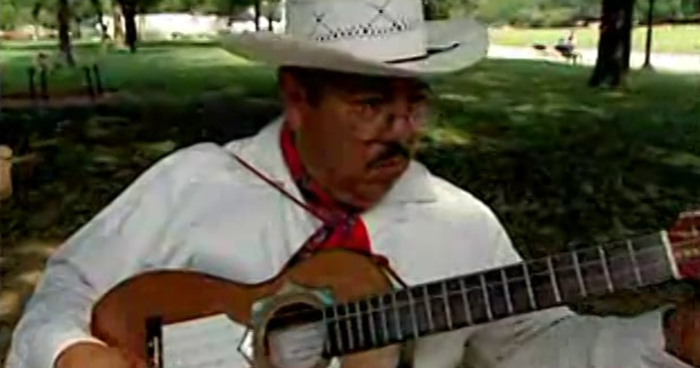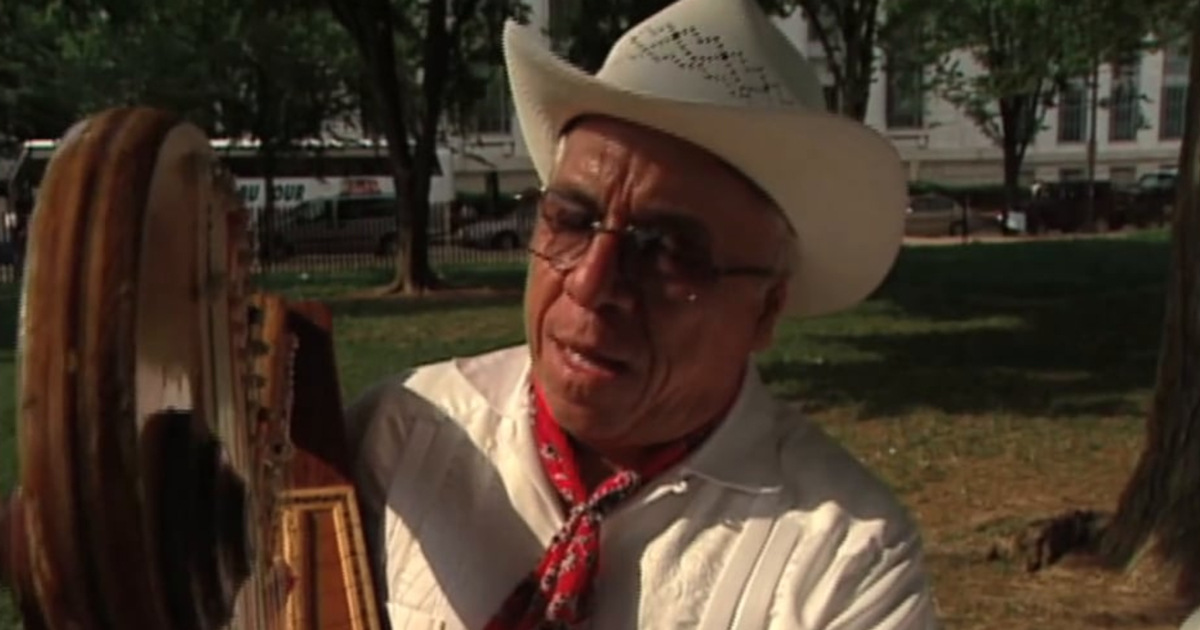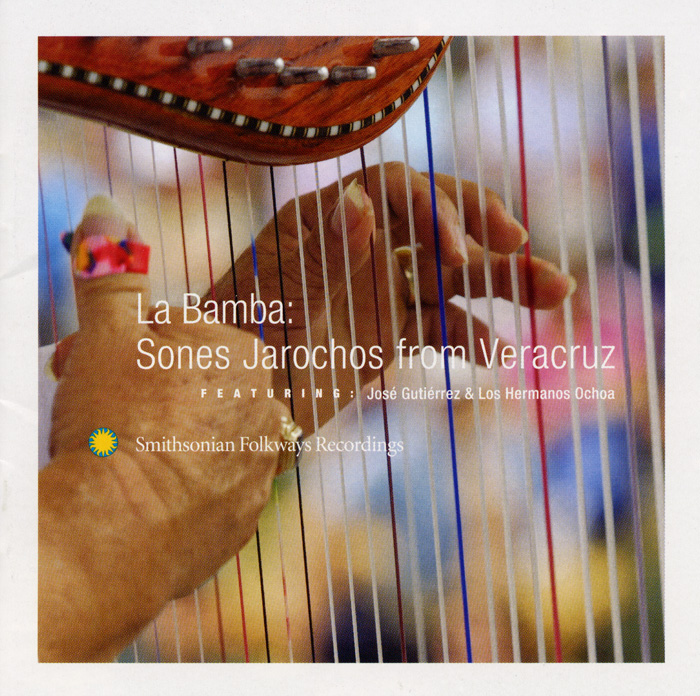José Gutiérrez and Los Hermanos Ochoa
Born and raised on the Costa de la Palma (Palm Coast) ranch near the town of Alvarado, an hour's drive south from the port city of Veracruz, Mexico, José Gutiérrez Ramón spent his childhood listening to his grandfather, father, and uncles play music for enjoyment after a hard day's work. While still a child, Gutiérrez learned to play the guitar, and later the principal instruments heard in the son jarocho tradition: jarana, requinto, and arpa (harp). Son jarocho (pronounced SOHN hah-ROH-cho), the music Gutiérrez and the brothers Felipe and Marcos Ochoa have performed for over fifty years as musical ambassadors of Veracruz's rich folk history, is the traditional rural music of the Gulf region of Mexico. Son describes the coplas or stanzas sung by a "caller" who is accompanied by the hard-driving rhythms of musicians playing Veracruz guitars and harp; jarocho describes the people and culture of Veracruz.

Although musicians developed son jarocho in Veracruz long before the turn of the 19th century, it wasn't until the latter half of that century that the tradition was recognized as an integral part of the Mexican culture and national identity. Mexico was still a republic of Spain at the time, and many of the earliest pioneers of the son jarocho were Spanish. Enslaved Africans in the 16th and 17th centuries are also given credit as contributors. In a 1844 article in the periodical El Museo Mexicano, José María Esteva observed that the sones performed by the jarochos represented a combination of various regional dances including the Canelo, Tusa, Guannábana, as well as Manola, Agualulco, and Tapatío. "The jarochos almost all dance the same way, " wrote Esteva, adding: "but with much grace." He continued: "Sometimes in certain sones, like the Bamba [the predecessor to the pop singer Richie Valens' hit "La Bamba"], one admires the agility with which they tap their heels and make a thousand movements."
More than just a musical genre, the son jarocho is a complex and indelible part of Mexican culture, particularly that of Veracruz with its coastal plains, calm beaches, seafood restaurants, and of course, the ranches that Gutiérrez and the Ochoa brothers call home. For them, the son jarocho is a vital link to their past and homeland.
As a teenager, José Gutiérrez moved to Boca del Río, a small town next to the port of Veracruz, to begin his professional musical career. There he gained experience performing with some of the best musicians of the day, like Lino Chávez, who became Gutiérrez's teacher and partner in the Conjunto Medellín in the early 1970s. During this time Gutiérrez also learned the skills of the caller (pregonero), or lead singer.

The pregonero has a high, clear, loud voice, knows the traditional repertoire of verses for each son, and can improvise verses about the topics at hand, such as the event being celebrated or the characteristics of the people attending the performance.
A caller might even ridicule a man in the audience for being with a different woman than the night before. In "La Bamba," "Sisquirí" and "La Morena" the caller displays all these skills as he grabs the listeners, making them follow his cries and laughter and pressing their active participation throughout the performance. "Good evening, gentlemen, ladies, and misses," begins "Sisquisirí," a favorite among conjuntos jarochos, "to all the little flowers with captivating faces go the prettiest verses from this trio of singers."
Other famous sones like "El Zapateado" (from zapato 'shoe') go further than call-and-response between musicians and audience. These provide the necessary accompaniment to a solo dancer who wants to show off his or her fancy footwork. Sones like "La Morena (The Dark Woman)" are often packed with folk wisdom. "Love for a woman was driving me crazy," Gutiérrez sings, but "another told me, let her go a bit, because she has to fall like a coconut from the palm tree."
For the Ochoa brothers, music was also a family affair. Born on Rancho de Zacaiste, near the inland town of Tierra Blanca (known for producing some of the greatest jarocho harpists), Felipe Ochoa remembers at a young age his father playing the harp. His father's example prompted Felipe to study and eventually master the modern arpa jarocha, a difficult instrument that stands nearly five feet tall and has from 32 to 36 strings covering five octaves. It is played with the fingers of both hands, one playing the bass strings (bordones) and the other playing chordal or arpeggiated melodies rich with syncopation on the high-pitched strings called trinos. At age 17, Felipe moved to Veracruz, where he played guitar with an elder harpist named Nicolás Sosa. Sosa and his group, Los Tiburones del Golfo (The Sharks of the Gulf), worked regularly in the Chato Moyo seafood restaurant near the fish market. Felipe played the guitar but took the opportunity to learn harp from Sosa. His older brother Marcos soon joined Los Tiburones, taking up the jarana. The two brothers stayed with Sosa for about fifteen years before Sosa retired, and they formed their own trio with Gutiérrez.
The two brothers are the backbone of the group. Felipe plays with an intensity that never lets up, and the older Marcos supplies the driving rhythm of the jarana with all the skills of a top-notch jaranero, laying down a rhythmically precise chordal foundation for the other instruments and adding creative flourishes and abrupt rhythmic stops that lift the others to a higher plane of performance. Gutiérrez has become the able third-man, and has filled this position playing with the Ochoa brothers for the past two decades. They have performed together on a wide range of occasions including weddings, baptisms, birthday celebrations, in local restaurants, and in major concerts of folk and dance throughout the world. More than any of their contemporaries, they appear to live out the comment made about early jarocho musicians in the 19th century: Wherever they perform it is always with "much grace" and with a "thousand movements."
During the Mexican Revolution of 1910, the son jarocho was co-opted along with other traditional Mexican folk as national cultural symbols by the Mexican Government. Later, the rise of the film and television industries in Mexico also meant that the son jarocho could be experienced not only in Mexico's rural towns but also in newly emerging urban centers. Today, the son jarocho occupies an important musical niche in Mexico's canon of folklore. José Gutiérrez and the Ochoa brothers are among the most celebrated performers of the tradition. They have toured throughout Central America, the United States, and Europe and more recently in the 2004 Smithsonian Folklife Festival in Washington, DC. Their lasting contribution to the son jarocho tradition has been preserved for future audiences in 2004's La Bamba: Sones Jarochos from Veracruz from Smithsonian Folkways Recordings.





